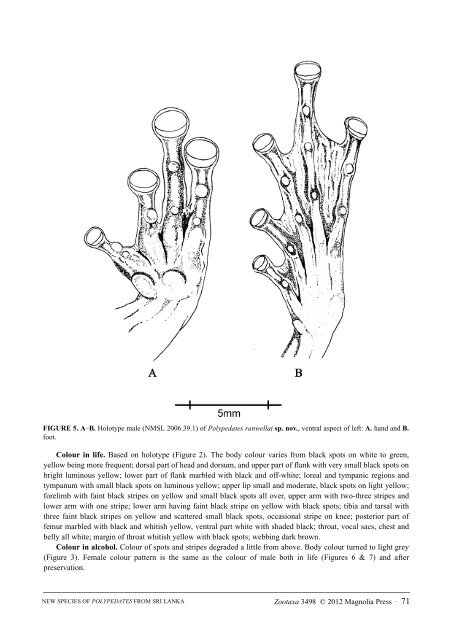Identification of Novel Species by Herpetological Foundation of Sri Lanka in Collaboration with Dilmah Conservation
Dilmah Conservation in collaboration with Herpetological Foundation of Sri Lanka has implemented a project on identification of new species of Herpetofauna, which will generate scientific evidence on their existence and promote conservation. This is the article published in Zootaxa Journal on the first new species identified as result of this research project – a species of Polypedates Tschudi …
Dilmah Conservation in collaboration with Herpetological Foundation of Sri Lanka has implemented a project on identification of new species of Herpetofauna, which will generate scientific evidence on their existence and promote conservation. This is the article published in Zootaxa Journal on the first new species identified as result of this research project – a species of Polypedates Tschudi …
You also want an ePaper? Increase the reach of your titles
YUMPU automatically turns print PDFs into web optimized ePapers that Google loves.
TERMS OF USE<br />
This pdf is provided <strong>by</strong> Magnolia Press for private/research use.<br />
Commercial sale or deposition <strong>in</strong> a public library or website is prohibited.<br />
FIGURE 5. A–B. Holotype male (NMSL 2006.39.1) <strong>of</strong> Polypedates ranwellai sp. nov., ventral aspect <strong>of</strong> left: A. hand and B.<br />
foot.<br />
Colour <strong>in</strong> life. Based on holotype (Figure 2). The body colour varies from black spots on white to green,<br />
yellow be<strong>in</strong>g more frequent; dorsal part <strong>of</strong> head and dorsum, and upper part <strong>of</strong> flank <strong>with</strong> very small black spots on<br />
bright lum<strong>in</strong>ous yellow; lower part <strong>of</strong> flank marbled <strong>with</strong> black and <strong>of</strong>f-white; loreal and tympanic regions and<br />
tympanum <strong>with</strong> small black spots on lum<strong>in</strong>ous yellow; upper lip small and moderate, black spots on light yellow;<br />
forelimb <strong>with</strong> fa<strong>in</strong>t black stripes on yellow and small black spots all over, upper arm <strong>with</strong> two-three stripes and<br />
lower arm <strong>with</strong> one stripe; lower arm hav<strong>in</strong>g fa<strong>in</strong>t black stripe on yellow <strong>with</strong> black spots; tibia and tarsal <strong>with</strong><br />
three fa<strong>in</strong>t black stripes on yellow and scattered small black spots, occasional stripe on knee; posterior part <strong>of</strong><br />
femur marbled <strong>with</strong> black and whitish yellow, ventral part white <strong>with</strong> shaded black; throat, vocal sacs, chest and<br />
belly all white; marg<strong>in</strong> <strong>of</strong> throat whitish yellow <strong>with</strong> black spots; webb<strong>in</strong>g dark brown.<br />
Colour <strong>in</strong> alcohol. Colour <strong>of</strong> spots and stripes degraded a little from above. Body colour turned to light grey<br />
(Figure 3). Female colour pattern is the same as the colour <strong>of</strong> male both <strong>in</strong> life (Figures 6 & 7) and after<br />
preservation.<br />
NEW SPECIES OF POLYPEDATES FROM SRI LANKA<br />
Zootaxa 3498 © 2012 Magnolia Press · 71















